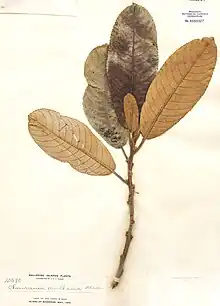Saurauia avellana
Saurauia avellana is a species of plant in the Actinidiaceae family. It is native to the Philippines.[2] Adolph Daniel Edward Elmer, the American botanist who first formally described the species, named it after the dense covering of hazel-colored (avellaneus in Latin)[3] downy hair covering the underside of its leaves. [4]
| Saurauia avellana | |
|---|---|
 | |
| Herbarium specimen of Saurauia avellana.[1] | |
| Scientific classification | |
| Kingdom: | Plantae |
| Clade: | Tracheophytes |
| Clade: | Angiosperms |
| Clade: | Eudicots |
| Clade: | Asterids |
| Order: | Ericales |
| Family: | Actinidiaceae |
| Genus: | Saurauia |
| Species: | S. avellana |
| Binomial name | |
| Saurauia avellana | |
Description
It is a bush reaching 3 to 5 meters in height. Its rigid leaves are variable in size, but are normally 20 by 8 centimeters with rounded tips. The leaves are hairless on their upper surface and dense with nut-brown hair on their lower surface. The leaves have 13-17 pairs of secondary veins emanating from their midribs. The leaf margins have small serrations. Its scaly petioles are 1-3 millimeters long. Inflorescences are axillary and organized on peduncles 1-5 millimeters in length. The peduncle can be branched and more than one can emerge from the same leaf axil. Each flower is on a scaly pedicel 3-5 millimeters in length. Its flowers have 5 sepals, 5 millimeters long, that are united at their base. The sepals are scaly on their outer surface and smooth on their inner surface. Its flowers have 5 white petals that are united at their base. The petals are smooth on both surfaces. Its flowers have numerous stamens that are 1.75 millimeters long. Its styles are 3 millimeters long. Each flower has a 3-chambered superior ovary. Each ovary contains numerous ovules.[4]
Reproductive Biology
The pollen of Saurauia avellana is shed as permanent tetrads.[5]
References
- "Saurauia avellana Elmer". Tropicos. Tropicos.org. Missouri Botanical Garden. n.d. Retrieved August 20, 2023.
- "Saurauia avellana Elmer". Plants of the World Online. The Trustees of the Royal Botanic Gardens, Kew. n.d. Retrieved December 18, 2018.
- Stearn, William (2004). Botanical Latin. Portland, Ore. Newton Abbot: Timber Press David & Charles. ISBN 9780881926279.
- Elmer, A.D.E. (1908). "Three Score of New Plants". Leaflets of Philippine Botany. 2: 463–526.
- Jagudilla-Bulalacao, L (1997) Pollen Flora of the Philippines, Volume 1, Taguig, Metro Manila: Department of Science and Technology, Special Projects Unit, Technology Application and Promotion Institute.